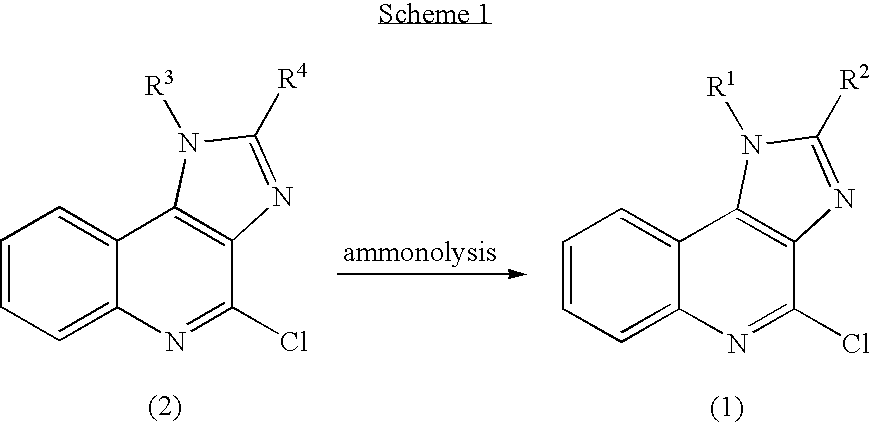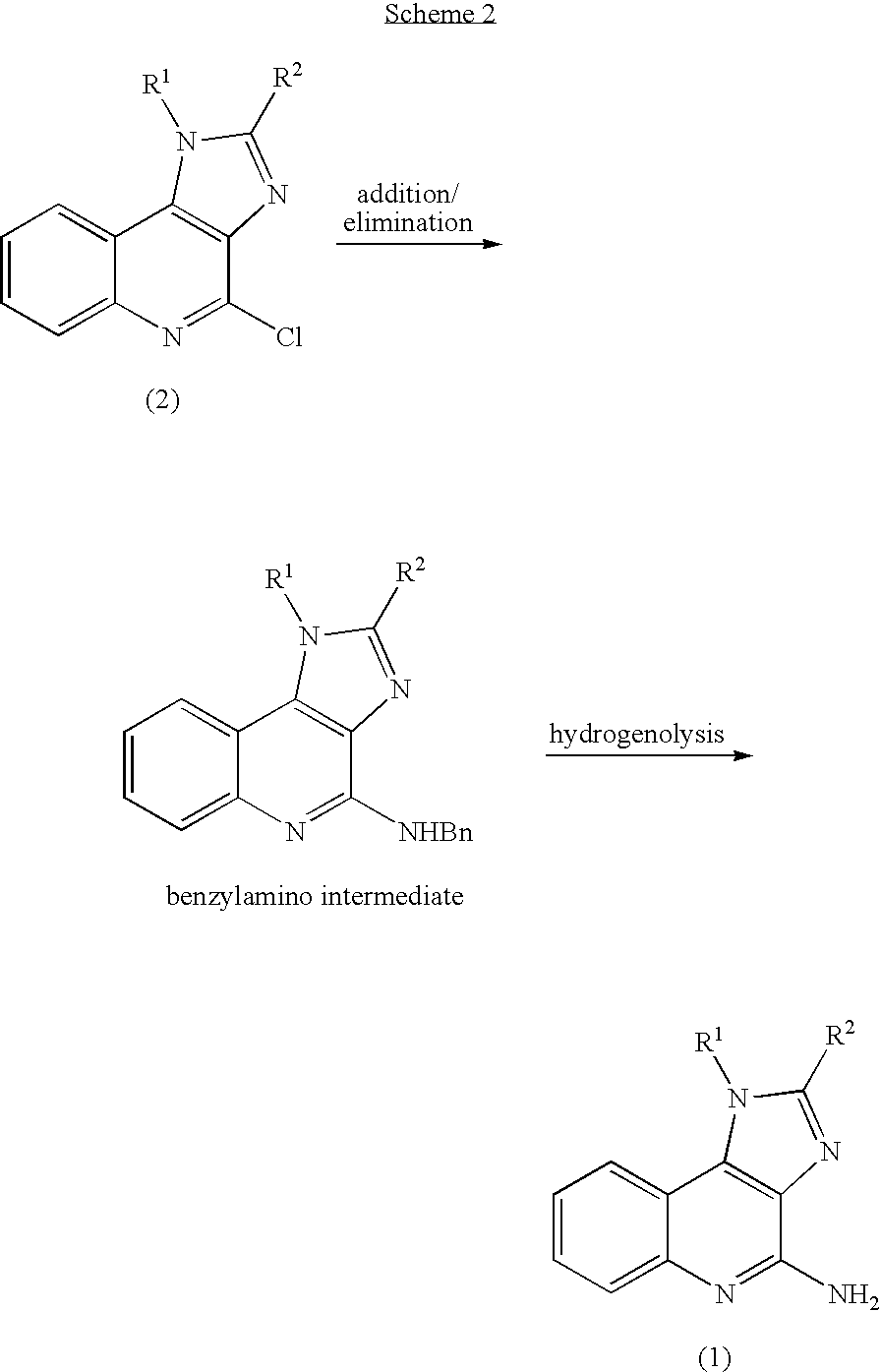Method of preparing 4-amino-1H- imidazo(4,5-c)quinolines and acid addition salts thereof
a technology of imidazo and quinoline, which is applied in the field of preparation of drugs, can solve the problems of high temperature of ammonolysis reaction in sealed reaction vessel, undesirable safety risk, and the need to remove reaction solvent by distillation, and achieve the effect of short reaction time and high yield
- Summary
- Abstract
- Description
- Claims
- Application Information
AI Technical Summary
Benefits of technology
Problems solved by technology
Method used
Image
Examples
example 1
Synthesis of 4-amino-1-isobutyl-1H-imidazo(4,5-c)quinoline (Imiquimod)
[0096] In this study, imiquimod was prepared in three steps, starting from 4-chloro-1-isobutyl-1H-imidazo(4,5-c)quinoline (compound of formula (2)).
Step 1: Preparation of 4-(N-benzylamino)-1-isobutyl-1H-imidazo(4,5-c)quinoline (Compound of Formula (4))
[0097] In a three-necked 100-mL flask, equipped with a thermometer, 20 grams of benzylamine and 10 grams of 4-chloro-1-isobutyl-1H-imidazo(4,5-c)quinoline were added with stirring. The resulting slurry was heated to 120° C.-130° C., and the reaction monitored by Thin Layer Chromatography (TLC; RP-18; mobile phase=80% acetonitrile:20% water).
[0098] When the TLC indicated the disappearance of 4-chloro-1-isobutyl-1H-imidazo(4,5-c)quinoline, the reaction mixture was cooled to room temperature resulting in a solid mass. 60 mL of water was added and the reaction mixture was stirred for 30 min. The solids were then separated by filtration and the solids were washed wit...
example 2
Synthesis of 4-amino-1-isobutyl-1H-imidazo(4,5-c)quinoline (Imiquimod)
[0101] In this study, imiquimod was prepared using the general three-step method exemplified in Example 1. However, different concentrations of sulfuric acid and sodium hydroxide were used in the second and third steps, respectively.
Step 1: Preparation of 4-(N-benylamino)-1-isobutyl-1H-imidazo(4,5-c)quinoline (Compound of Formula (4))
[0102] 4-(N-benzylamino)-1-isobutyl-1H-imidazo(4,5-c)quinoline was prepared using the general method exemplified in Example 1.
Step 2: Preparation of Acid Addition Salt (Compound of Formula (5))
[0103] In a three-necked 500-mL flask, equipped with mechanical stirrer and thermometer, 60 mL of aqueous 30%-70% sulfuric acid was introduced. 20 grams of 4-(N-benzylamino)-1-isobutyl-1H-imidazo(4,5-c)quinoline were added, causing the temperature to increase to 75° C. The mixture was heated between 70° C. and 100° C. until TLC indicated the reaction was complete (about 1 hour).
[0104] Th...
example 3
Synthesis of 4-amino-1-isobutyl-1H-imidazo(4,5-c)quinoline (Imiquimod)
[0106] In this study, imiquimod was prepared using the general three-step method exemplified in Examples 1 and 2. However, a different procedure was used to isolate the acid addition salt.
Step 1: Preparation of 4-(N-benzylamino)-1-isobutyl-1H-imidazo(4,5-c)quinoline (Compound of Formula (4))
[0107] 4-(N-benzylamino)-1-isobutyl-1H-imidazo(4,5-c)quinoline was prepared using the general method exemplified in Example 1.
Step 2: Preparation of Acid Addition Salt (Compound of Formula (5)
[0108] In a three-necked 500-mL flask, equipped with mechanical stirrer and thermometer, 60 mL of aqueous 70% H2SO4 was introduced. 20 grams of 4-(N-benzylamino)-1-isobutyl-1H-imidazo(4,5-c)quinoline was added, causing the temperature to increase to about 75° C. The mixture was heated to about 100° C. until TLC indicated the reaction was complete (about 1 hour). The reaction mixture was cooled to about 80° C., 80 mL of toluene was a...
PUM
| Property | Measurement | Unit |
|---|---|---|
| Temperature | aaaaa | aaaaa |
| Temperature | aaaaa | aaaaa |
| Fraction | aaaaa | aaaaa |
Abstract
Description
Claims
Application Information
 Login to View More
Login to View More - R&D
- Intellectual Property
- Life Sciences
- Materials
- Tech Scout
- Unparalleled Data Quality
- Higher Quality Content
- 60% Fewer Hallucinations
Browse by: Latest US Patents, China's latest patents, Technical Efficacy Thesaurus, Application Domain, Technology Topic, Popular Technical Reports.
© 2025 PatSnap. All rights reserved.Legal|Privacy policy|Modern Slavery Act Transparency Statement|Sitemap|About US| Contact US: help@patsnap.com



